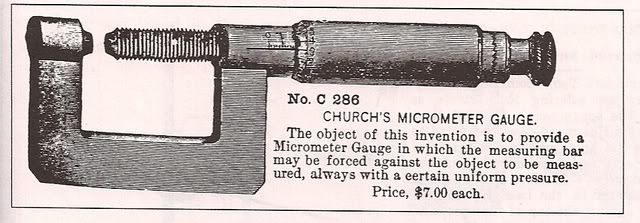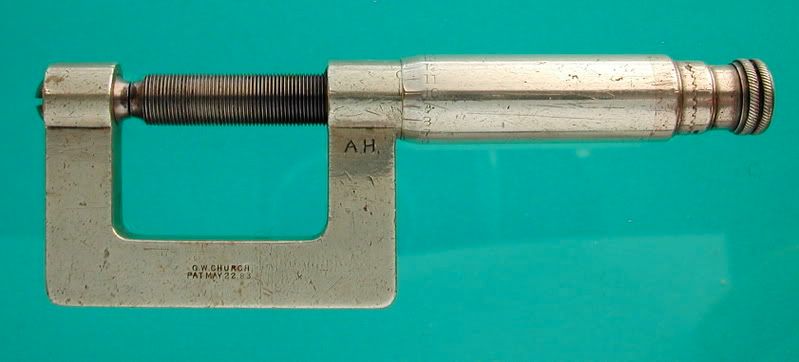rivett608
Diamond
- Joined
- Oct 25, 2002
- Location
- Kansas City, Mo.
Sometimes someone invents something that is almost timeless.... in the case of machinist tools one of those would be the ratchet on the back of the micrometer. Think of how many millions of these have been made? In Europe they already had the friction thimble, but it could vary more from one mic to another depending on how tight it was adjusted so the need for a better system was needed.
So the grandson of Henry Frasse (Frasse & Co. was the MSC of the late 19th century) a Mr. George W. Church invented the ratchet and patented it on May 22 1883. This patent was later licensed to Brown & Sharpe and possibly others, after it expired everybody used it.
Less than 6 of Church's original mics are know to exist..... some unmarked, but they bring up some interesting questions..... like who made these? They are different from almost all other American micrometers in a number of ways. These features are very similar to to some English mics...... so where they made there? or here in the US by a UK trained machinist? The feature of interest are the square frame, a 50 pitch screw so the thimble is divided by 20 not 25, also the angle looks like 55º and they are made of solid Nickel Silver. The ratchet has exposed teeth and nice rope knurling.
Church also made speed indicators (a bunch are known) and two sizes of bench micrometers are shown in a few catalogs but no examples have been found.
So think of the fun it is to hold something that had a major change for over 100 years to the use of something as common as a micrometer.......


So the grandson of Henry Frasse (Frasse & Co. was the MSC of the late 19th century) a Mr. George W. Church invented the ratchet and patented it on May 22 1883. This patent was later licensed to Brown & Sharpe and possibly others, after it expired everybody used it.
Less than 6 of Church's original mics are know to exist..... some unmarked, but they bring up some interesting questions..... like who made these? They are different from almost all other American micrometers in a number of ways. These features are very similar to to some English mics...... so where they made there? or here in the US by a UK trained machinist? The feature of interest are the square frame, a 50 pitch screw so the thimble is divided by 20 not 25, also the angle looks like 55º and they are made of solid Nickel Silver. The ratchet has exposed teeth and nice rope knurling.
Church also made speed indicators (a bunch are known) and two sizes of bench micrometers are shown in a few catalogs but no examples have been found.
So think of the fun it is to hold something that had a major change for over 100 years to the use of something as common as a micrometer.......




